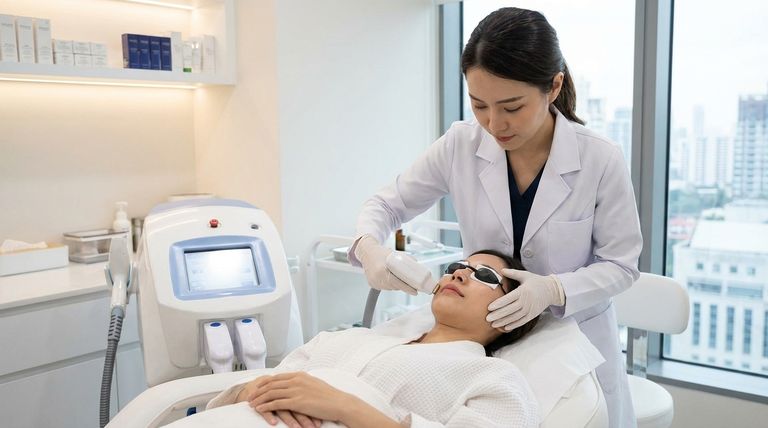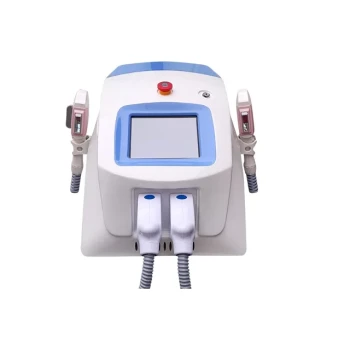To get the best results from IPL, you must focus on three key areas: diligent pre-treatment preparation, consistency during your treatment series, and strict post-treatment care. The single most important factor is avoiding sun exposure, as a tan dramatically reduces the treatment's effectiveness and increases the risk of side effects. This preparation ensures the light energy is focused precisely on its target—be it hair follicles or pigmentation—rather than being absorbed by the surrounding skin.
The core principle for successful IPL is maximizing the contrast between your skin tone and the target (hair or pigment). Every preparatory step you take is designed to enhance this contrast, making the treatment safer, more comfortable, and significantly more effective.

How IPL Actually Works: Light, Heat, and Contrast
To optimize your results, you first need to understand the science. Intense Pulsed Light (IPL) is not a true laser; it's a device that emits a broad spectrum of light wavelengths.
The Role of Melanin (The Target)
The light energy from an IPL device is specifically attracted to and absorbed by melanin, the pigment that gives color to our hair and skin. This is the fundamental mechanism of action.
The Principle of Selective Photothermolysis
When melanin absorbs this intense light, the energy is instantly converted into heat. This process, known as selective photothermolysis, heats and damages the target structure—like a hair follicle or a cluster of pigmented cells—while leaving the surrounding, lighter-colored skin tissue unharmed.
Why Contrast is Everything
Effective treatment depends on the light being absorbed by the target, not your skin. If your skin is tanned, it contains more melanin. The IPL device cannot distinguish between the melanin in your skin and the melanin in your hair or sunspot. This forces the technician to use a lower energy setting to avoid burning you, which directly leads to less effective results.
Maximizing Results: The Pre-Treatment Protocol
Your actions in the weeks leading up to your first appointment are critical for setting the stage for success.
Avoid Sun Exposure Religiously
This is the most important rule. You must avoid any form of tanning—from the sun, tanning beds, or even self-tanning lotions—for at least two to four weeks before your session. Sun exposure floods your skin with melanin, creating a "competing target" that reduces the treatment's impact and increases your risk of burns. Use a broad-spectrum SPF 30 or higher daily.
Pause Certain Skincare Products
For at least one week before your appointment, stop using any products that can make your skin more sensitive. This includes topical retinoids (Retin-A, tretinoin), retinol, benzoyl peroxide, and chemical exfoliants like glycolic or salicylic acids (AHAs/BHAs).
Shave, Don't Wax or Pluck
If you are treating unwanted hair, shave the area 12 to 24 hours before your appointment. Shaving leaves the hair shaft and follicle intact under the skin, providing a perfect target for the IPL energy. Waxing, plucking, or epilating removes the hair from the follicle, leaving nothing for the light to target.
Arrive with Clean Skin
On the day of your treatment, the target area should be completely clean. Do not apply any makeup, lotions, oils, or deodorant to the area being treated, as these can block the light or cause adverse skin reactions.
During Your Treatment Series: Consistency is Key
Getting optimal results requires more than a single session. It's a cumulative process.
Stick to the Recommended Schedule
Your technician will recommend a specific interval between sessions, typically 4-6 weeks. This schedule is designed to target hair during its active growth phase (the anagen phase) or to progressively break down pigmentation. Skipping appointments or waiting too long between them can disrupt this cycle and diminish your final results.
Communicate with Your Technician
Always inform your provider of any changes since your last visit. This includes any new medications (especially antibiotics, which can cause photosensitivity), recent sun exposure, or any unusual skin reactions. This allows them to adjust the treatment settings for your safety and efficacy.
Understanding the Trade-offs and Limitations
Objectivity is crucial for managing expectations. IPL is a powerful tool, but it is not a magic wand.
Not All Skin and Hair Types are Equal
IPL is most effective for individuals with light skin and dark hair or pigment. Because it targets melanin, it is generally ineffective on very light hair (blonde, grey, white, or red) as there is no pigment to absorb the light. Furthermore, it carries a higher risk of burns or pigmentation changes on darker skin tones, requiring a highly experienced technician and specialized equipment.
Results Are a "Reduction," Not Always Permanent
For hair removal, the FDA-approved term is "permanent hair reduction," not removal. While many people achieve excellent, long-lasting results, hormonal changes or other factors can cause some hair to regrow over time. Most individuals require occasional maintenance sessions every year or two to maintain their results.
The Risk of Side Effects
When performed correctly, IPL is very safe. However, improper preparation (like having a tan) or incorrect device settings can lead to side effects. These range from temporary redness and swelling to more serious burns, blisters, or changes in skin color (hyper- or hypopigmentation). Following pre- and post-care instructions is your best defense.
Making the Right Choice for Your Goal
Your preparation strategy should align with your specific treatment objective.
- If your primary focus is hair removal: Your most critical actions are shaving the area beforehand (never waxing) and adhering strictly to the treatment schedule to target hair in its active growth phase.
- If your primary focus is correcting sun spots or redness: Your success hinges on meticulous sun avoidance before and during your treatment series, as any new pigment will counteract the benefits.
- If you have a medium to dark skin tone: Your top priority must be finding a provider with extensive experience treating skin of color and who may recommend an alternative technology, like an Nd:YAG laser, which is safer for melanin-rich skin.
By understanding the principles behind the technology and committing to the proper protocol, you empower yourself to achieve the best possible outcome from your IPL treatments.
Summary Table:
| Key Factor | Action for Best Results |
|---|---|
| Sun Exposure | Avoid all tanning for 2-4 weeks pre-treatment. Use daily SPF 30+. |
| Skincare | Stop retinoids, AHAs/BHAs 1 week before treatment. |
| Hair Removal | Shave 12-24 hours before; do not wax or pluck. |
| Treatment Schedule | Adhere to the 4-6 week interval between sessions. |
| Skin & Hair Type | Most effective on light skin with dark hair/pigment. |
Ready to achieve superior IPL results for your clinic?
At BELIS, we specialize in providing professional-grade medical aesthetic equipment to clinics and premium beauty salons. Our advanced IPL systems are engineered for precision, safety, and outstanding clinical outcomes, helping you deliver the best possible results to your clients.
Let us help you enhance your service offerings and grow your business.
Contact our experts today to find the perfect IPL solution for your practice.
Visual Guide

Related Products
- Clinic Use IPL and SHR Hair Removal Machine with Nd Yag Laser Tattoo Removal
- IPL SHR Hair Removal Machine for Permanent Hair Removal
- IPL SHR+Radio frecuency machine
- Multifunctional Laser Hair Growth Machine Device for Hair Growth
- Multifunctional Laser Hair Growth Machine Device for Hair Growth
People Also Ask
- How much do IPL treatments cost? A Guide to Investing in Clear, Smooth Skin
- Can you see results after 1 IPL? What to Expect from Your First Treatment
- What are the negative effects of IPL? Understanding Risks for Safe Treatment
- Is IPL safe on breasts? A Guide to Safe Treatment and Avoiding Risks
- Does hair removal work better than shaving? Get Smoother, Longer-Lasting Results



















